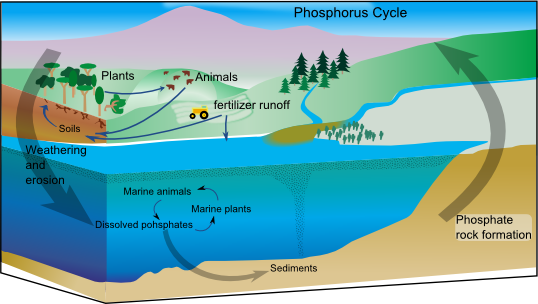Dynamic Homeostasis
Organisms must exchange matter with the environment to grow, reproduce, and maintain organization --The College Board, 2015
Molecules and atoms from the environment are necessary to build new molecules.
Cell parts are similar to machine parts in that they do wear out or are used up over time and must be replaced with new parts. Remember, however, a cell "part" is really a collection of atoms that combine to form the basic macromolecules that largely compose living things: namely carbohydrates, proteins, lipids, or nucleic acids. The fundamental units (atoms) that make up these macromolecules cycle from the environment to organisms in several ways.
All organic compounds contain carbon. Carbon is a storage molecule as well as playing an integral role in cell formation. So how does carbon get from the environment to living organisms?
Image Credit: Wikimedia Commons
Required Reading (SCHS): Starr & Taggart p.118-119. Be prepared for a quiz question or class discussion measuring your knowledge of how carbon moves from the environment to organisms where it is used to build carbohydrates, proteins, lipids, or nucleic acids.
With your understanding of the carbon cycle, think about how other essential atoms such as nitrogen and phosphorus move from the environment to living things.
Nitrogen is used in building proteins and nucleic acids while phosphorus in involved in building nucleic acids and certain lipids.

Image Credits: "Nitrogen Cycle" by Environmental Protection Agency - http://www.epa.gov/maia/html/nitrogen.html. Licensed under Public Domain via Wikimedia Commons - https://commons.wikimedia.org/wiki/File:Nitrogen_Cycle.jpg#/media/File:Nitrogen_Cycle.jpg

Image Credits: "Phosphorus cycle" by BonniemfIncorporates work by NASA Earth Science Enterprise - Reworked by Bonniemf from the public domain file File:Carbon cycle-cute diagram.svg. Licensed under CC BY-SA 3.0 via Wikimedia Commons - https://commons.wikimedia.org/wiki/File:Phosphorus_cycle.png#/media/File:Phosphorus_cycle.png

No comments:
Post a Comment